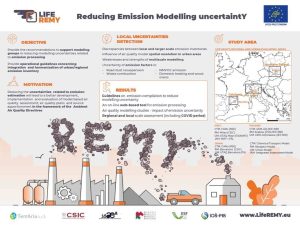Air quality: Reducing Emission Modelling uncertainty
The REMY project (acronym for Reducing Emission Modelling uncertainty), through a detailed quantitative modelling analysis in three critical areas of the EU (Po Valley – IT, Catalonia – ES, Southern Poland – PL), studies the impact of uncertainty in pollutant emission and air dispersion patterns that could negatively affect air quality, both at regional and local scales, leading to the identification of ineffective emission abatement strategies.
| Project type: LIFE Preparatory Project, Grant Agreement n. LIFE20 PRE/IT/000004, European Union Budget: 1’538’414 Euro (923’048 Euro EU-funded), 432’922 Euro managed by TerrAria Duration: 2021 – 2024 Number and Partners involved: 5 project partners: TerrAria Srl (TA), Agenzia Mobilità Ambiente e Territorio Srl (AMAT), Consejo Superior de Investigaciones Científicas (CSIC), Institute of Environmental Engineering- National Research Institute (IEP-NRI), Ricerca Sistema Energetico (RSE) Role: Coordinating beneficiary Project website: liferemy.eu |
 |
The main objective of the project is to provide up-to-date, comprehensive and harmonised recommendations that can support modelling teams in reducing modelling uncertainties and thus contribute to a better development, implementation and analysis of air quality assessment, air quality plans and emission source apportionment in the framework of the Ambient Air Quality Directives. Through specific simulations, both at regional and urban level, in three different areas of the EU, the project focused on reducing the most relevant modelling uncertainties related to emission processing, with the aim of providing operational guidelines on:
- The integration and harmonisation of the local/regional emission inventory also through an online web application;
- Emission estimates for the most uncertain sources such as (I) resuspension emissions from road traffic (II) residential solid combustion and pizzerias, (III) open burning of waste also with feedback from the modelling part;
- The modelling of emission and formation processes concerning the generation of primary and secondary organic particulates;
- Multi-scale modelling in urban and peri-urban areas including both Chemical Transport Model (CTM) and local modelling and also incorporating spatially variable resuspension.
THE ROLE OF TERRARIA
Within the project, TerrAria is responsible for the sensitivity analysis of the urban modelling in both the baseline and COVID-19 scenarios, as well as for the development of guidelines and recommendations to support the compilation of emission inventories. TerrAria was also in charge of managing the entire project.


